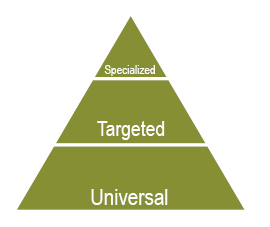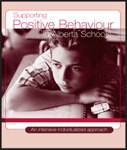
|
Universal Supports benefit all students
- Work collaboratively with school staff to ensure that there are school-wide expectations for following adult directions and a commitment for consistent prompting of behaviours, such as:
- stopping and acknowledging (with a nod or 'yes') when an adult speaks
to student
- following through on adult requests right away
- asking for clarification or help in a polite voice
- if necessary, disagreeing in an agreeable way.
- Teach classroom expectations related to responding to adults (e.g., use discussion, role-play).
- Use strategies that increase the likelihood that students will follow directions, such as making eye contact, giving specific requests, giving students time to respond to directions and redirecting behaviour to avoid power struggles.
- Post visual reminders on
the importance of following adult directions and outlining
related behaviours. When appropriate, collaborate with students
to develop these visual reminders.
- Use descriptive feedback to reinforce students when they follow adult directions quickly and cooperatively.
|
|

|
Targeted Supports benefit students with more specific needs
- Pair individual students with positive peers who can serve as role models and provide support in responding appropriately to adult direction and requests. Rotate these peers at regular intervals throughout the school year.
- Provide proximity by positioning yourself nearby individual students who may require support in following adult directions.
- Use positive, limited choices to encourage cooperation (e.g., "Do you want to do your math at the table or on the floor?").
- Help students understand their own behaviour (e.g., how they look and sound when responding to adult direction) through verbal descriptions, physical demonstrations, modelling and the use of video feedback.
- For students who require increased structure and reassurance, develop and review social stories for specific situations when it is essential to follow adult directions (e.g., during an emergency evacuation, fire drill, on a field trip).
- Practise following directions through role-playing situations.
- Work with the student to develop low-key cues and prompts that you can use to remind the student to cooperate and follow directions.
- Develop self-monitoring strategies for students to reflect on and keep track of their own behaviour related to responding positively to adult direction.
- Set up a systematic approach to reinforcement for students who are working on improving their response to adult direction. Reinforcement should encourage moving toward intrinsic motivation (e.g., "How does it feel
when …?").
|
Parents know their children well and can offer insights on how to support
their social and emotional well-being. There is strength in collaborating
on strategies that could be used at home, at school and in the community.
|

|
Specialized Supports benefit the small number of students with sensory, physical, cognitive or behavioural needs that require intensive, individualized interventions
- Work with the student and family to help develop an individual behaviour
support plan focused on following adult
directions. Identify a reinforcement system
that will be meaningful to the student and manageable
for school staff.
|
|








